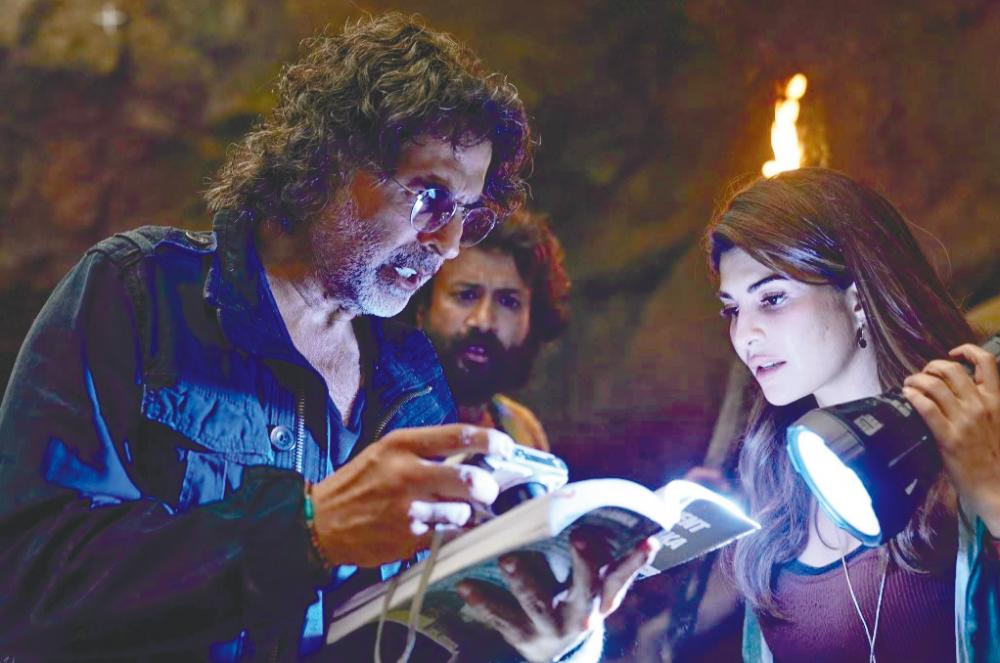RAM Setu translates to “Ram’s Bridge”, an ancient bridge made of limestone shaols written about in the Ramayana epic, connecting Pamban island, Tamil Nadu, India, to Mannar island in Sri Lanka. Parts of the ‘bridge’ have sunk under the sea over the centuries.
The bridge holds a special significance in the Ramayana, as it was made by Lord Ram, or Rama, to cross over the ocean to reach Sri Lanka Island, and rescue his wife Sita, who was held captive by the demon king Ravana.
The Vanaras (creatures with monky faces and human bodies), under the supervision of architects Neel and Nala, were said to have helped to carry huge boulders to construct the ‘floating’ limestone shoals within five days, and they exist under the surface of the sea today.
In the movie, Akshay Kumar plays an archaeologist, Dr. Aryan Kulshrestha, tasked with doing a report on the origin of the bridge, which was to be presented in an on-going case in the Supreme Court, seeking to demolish some parts of the bridge to make a way for progressive development.
In his report, Akshay states that the Ram Setu bridge was formed by natural sediments over hundreds of years, specifically more than 20,000 years ago, and pre-dates Ram’s era, which was about 7,000 years ago.
Inadvertently, it meant Lord Ram did not build the bridge as stated in the Ramayana, raising doubts over the epic. This irks the people, and soon he finds himself being accused of blasphemy and a target of angry protestors.
However, a shipping company owner, Indrakant Varma (played by Nasser), hires him along with a group of researchers, which includes environmentalist Sandra (Jacqueline Fernandes), to do further research on the bridge to substantiate the theory.
Surprisingly, the result of the research proves otherwise. The “carbon dating’ of the component of the rocks or “floating stones” (used to build the bridge) dates back to 7,000 years ago and not the estimated time period, contradicting Aryan’s earlier report.
Now, Aryan is convinced by the research results, but things take a different turn, at this point.
As Indrakant wants a favourable report to demolish the bridge to allow his ships to use a shorter route or navigation and to save costs in terms of fuel, the businessmen’s people try to kill the researchers by sabotaging their underwater research vehicle, while submerged in the depths of the sea.
They managed to escape and were saved by a Sri Lankan fisherman and tourist guide, Anjaneya Pushpakumaran, or AP, on the Sri Lankan coast.
Coincidentally, Anjaneya is another name for Lord Hanuman, a key supporter of Ram, in the journey of saving Sita from Ravana in the epic.
Aryan goes on an adventure to search for concrete evidence to support his results to present in court, and in the process, he discovers secret passages to the remains of Ravana’s palace, proving the Rama-Ravana saga did actually take place.
In the movie, Akshay is an atheist who does not believe in anything that can’t be proven scientifically, including god and religion, but he makes a 180-degree turn and defends the divine origin theory in the latter part of the movie, and this change of mind makes us root for the character.
However, at some point, his character turned into something of an Indiana Jones, searching for lost artifacts following ancient trails through waterwalls, lakes, and mountains to reach Ravana’s ruined palace (which was said have been set on fire by Hanuman), and this takes place against the backdrop of a civil war in Sri Lanka, shown briefly.
The actor does deliver a good performance in some of his scenes.
For example, in one courtroom scene, Aryan questions why development around certain historical monuments takes into consideration possible damage and ensures the heritage buildings are preserved.
In his arguement, he said that while there are many historical places referred to as Ram, there is only one Ram Setu, as such it should be preserved and not damaged.
The movie explores a new idea or concept in Bollywood that is different than usual subjects and sparks interest due to its connection to the Ramayana, an epic that most Hindus have been taught or learned since childhood – but don’t expect a great adventure story.
Some discoveries in the movie are believable, like the finding of the ‘floating’ stones, but the ‘adventurous’ parts of the film, such as the trip through the mysterious tunnel to Ravana’s ruined palace, shows a lack of imagination.
First, it did not take much difficulty or hardship to find the hidden place, located deep inside forests, mountains, and lakes. It was just too easy and the tunnel leading to the palace clearly looks unrealistic, as it looks more like a movie set from a teen flick.
As for acting, Nasser was good, and another actor, Satya Dev Kancharana, a Telegu actor who plays the role of Anjaneya Pushpakumaran, stands out. Satya has a good screen presence and is entertaining to watch, though he has only made a few appearances.
Aside from being a tourist guide, who goes out of his way to help, AP miraculously knows all the answers and accurate information that sets them on the right path or direction to find the relevant evidence.
However, there is something mysterious about him from the beginning, and (spoiler alert!) his secret identity gets revealed only at the very end of the movie.
As per media reports in India, there was a proposed shipping canal project to dredge a part of the sea-bridge in Tamil Nadu in 2005, but it was opposed on religious, environmental, and economic grounds, and the work stopped after a Supreme Court order.
I am not sure if the story was inspired by the real-life incident, but it is certainly entertaining and exciting to watch things unfold until the end and the discovered artifacts, despite some flaws.










